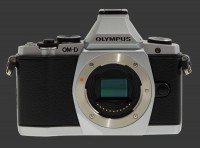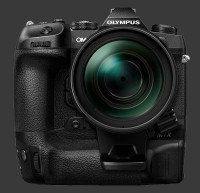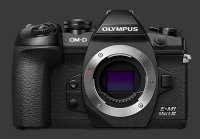Olympus OM-D E-M1 Mark III Review
Olympus OM-D E-M1 Mark III Performance - How well does it take pictures?
Performance starts with image quality, which is the criteria used as the foundation of our digital camera ratings. Ergonomic issues may get in the way, but in the end, image quality counts the most. For an ILC, image quality greatly depends on the lens used. While color, noise, exposure and dynamic-range are properties of a camera, distortion, vignetting and chromatic aberrations are properties of the lens. Sharpness and contrast depend on the weakest link. That is, a camera cannot capture more details than a lens lets through. Conversely, it is quite possible for a lens to transmit more details than a sensor can capture.
NOTE Image quality and processing from the Olympus OM-D E-M1 Mark III is identical to its predecessor. The three next sections of this review are identical to the ones for the Mark II.

Image Noise & Details
The Olympus OM-D E-M1 Mark III delivers outstanding image-quality for a Micro Four-Thirds camera, besting the original E-M1, despite an increase in resolution from 16 to 20 megapixels. While previous generation Micro Four-Thirds cameras narrowed the gap between Micro Four-Thirds and APS-C, the latest generation of APS-C sensors significantly improved and are leaving Micro Four-Thirds further behind than it has been since the E-M5
Olympus OM-D E-M5. The difference is dramatic in low-light yet not so much in bright light.
Image noise is extremely low until ISO 800 and barely there at 1600 where it remains usable for relatively large prints. ISO 3200 shows a fine pattern of visible noise. The finest details get very slightly soft yet this sensitivity remains quite usable for medium-sized prints. There is another further increase in noise at ISO 6400, still mostly luminance noise, along with damage to fine details. A mid-size print would remain acceptable without much issue.
There is a notable leap in image-noise at ISO 12800. It is almost all luminance noise but stronger than at ISO 6400. Small details really get eaten away at this leveling, leaving this only usable for small prints. Remarkably though, the E-M1 Mark III maintains excellent color and contrast at this sensitivity. ISO 25600 though is very noise and quite soft, there is not much that can be done with it. This is an improvement over previous Micro Four-Thirds sensors yet not enough to make this usable.
Three levels of noise-reduction are available. NR can also be turned off entirely which avoids increased softness at high sensitivities. Best results are obtained with Noise-Reduction turned off and Sharpness at +1. Anything higher shows clear sharpening artifacts on this camera which does not have an anti-alias filter.

Color & White Balance
Color accuracy of the OM-D E-M1 Mark III is similar to its predecessor. Natural style delivers reasonable colors. Still, the red channel always remains too high. Default Saturation is punchy yet not overdone. Dialing it down one step produces more natural results. Similarly, the default contrast is high. This produces deep images at the expense of shadow detail. Luckily, all OM-D cameras offer fine control over the tone-curve, independently for shadows and highlights, with a global contrast setting too.
Automatic While-Balance is disappointing. Results are highly variable and even shooting in broad daylight can lead to a bluish tint. Indoor lighting is particularly difficult for the E-M1 Mark III where it sometimes leaves a strong yellow cast even with the Preserve Warm Colors option turned off. Any of the preset immensely helps and Custom WB is spot on. This is a little more work yet makes it possible to capture neutral colors under most lighting conditions.
Exposure
This digital camera has a reasonable multi-segment metering system. Scenes which fall within its dynamic-range are exposed towards the mid-tone which makes them look natural. High contrast-scenes are rendered brightly which causes more highlight clipping than usual. Most scenes get properly exposed though unless backlit. One can fine-tune exposure and gradation to improve results as needed, although it has to be redone frequently since it really depends on the scene.
The Olympus OM-D E-M1 Mark III shows one of the best dynamic-range from a Micro Four-Thirds sensor, only arriving in second place by a fraction of a stop. Compared to modern APS-C cameras, the gap is now significant with those capable of handling over 1½ stops more dynamic-range. This is considerable disadvantage for landscape photography where directly illuminated areas and shadows frequently share the scene.
NOTE The remaining of this review is specific to the Mark III that features an improved autofocus engine.

Auto Focus
While the Mark II introduced an entirely new hybrid autofocus system, the Mark III refines it. Autofocus is based around an on-sensor 121-Point Phase-Detect AF system complemented by Contrast-Detection. Points cover a broad area of the sensor, allowing this mirrorless to focus nearly anywhere within the frame. All points are equally sensitive and usable with any lens.
This hybrid AF-system focuses incredibly fast and is highly sensitive to light. As with any on-sensor autofocus system, this one cannot suffer from any front or back focusing issue. Still, Olympus includes AF Fine-Tuning in case there is an issue with some lenses. This is not completely infallible as certain lenses may exhibit focus-breathing which shifts the plane of focus when stopping down for the exposure, while autofocus is performed with the aperture wide-open.
A new Starry-Sky AF mode was added specifically for astro-photography. It allows the camera to focus on point light-sources which previously caused frequent focus errors. Also new is a second pass AF Scanner that corrects focus when the standard algorithm fails to lock focus. This optionally runs once or continuously. Tracking sensitivity can be adjusted in 5 levels too. Professional lenses sometimes feature a Focus Limiter but now Olympus added this feature directly into the E-M1 Mark III which supports 3 custom limits, providing more flexibility than any lens on the market.
Clearly the new autofocus implementation of the Olympus OM-D E-M1 Mark III is a tremendous improvement over its predecessor. Focus missing are extremely rare and speed is more consistent than before. Tracking took a huge leap forward with the ability to track faces and eyes, even with left or right eye prioritization.
With most Micro Four-Thirds lenses, focus is done via a fly-by-wire ring around the lens-barrel. The E-M1 Mark III keeps up well with no perceptible lag. In DMF mode, a slight turn of the focus-ring shifts into manual focus. Because the ring is fly-by-wire, the E-M1 Mark III can reverse the direction for focusing except for those few lenses with a mechanical focus-ring.

Speed
The E-M1 Mark III is built for speed. It is one of the fastest digital cameras ever made, regardless of type, and is extremely responsive. Every single button, switch and dial gets an immediate response. The Eye-Start Sensor instantly toggles the EVF which manages to keep up with action incredibly well. One of the dual SDXC memory-card slots offers UHS-II throughput, which reduces buffer clearing time.
Continuous drive speed is best-in-class, reaching 60 FPS at full-resolution when using the electronic-shutter or 15 FPS when using the mechanical-shutter. The hybrid shutter itself offers the fastest speeds for both electronic and mechanic mode at 1/32000s and 1/8000s respectively. The electronic shutter is completely silent. Using Pro Capture mode, grabbing 60 frames in a second without hearing any noise seems like magic! Just be ready to sort through that many pictures later.
In use, the Olympus OM-D E-M1 Mark III rarely holds back the photographer. The main exception if High Res capture mode where a single press of the shutter-release produces a single image from 8 individual exposures and blends them together. The display goes blank at the beginning and end of the process, while it shows intermediate frames in between.
The following measurements characterize the performance of the OM-D E-M1 Mark III:
- Power-On: ½ second. Excellent.
- Power-On to First-Shot: 1 second. Superb.
- Autofocus: Faster than ¼s even in dim light, slightly more in very low-light. Class-leading!
- Shutter-lag: Instant with virtually no blackout. Best-in-class.
- Shot-to-shot: Under ½s. Impressive.
- Playback: Instant to enter and exit. Class-leading.
- Power-Off: ¼ second. Excellent.
- Video: Immediate start and stop. Perfect.
The Olympus OM-D E-M1 Mark III again delivers an unprecedented performance by exceeding its class-leading predecessor in a few areas. This camera particularly delivers on its promise of speed with its combination of instant shutter-lag, no black-out and ultra-fast autofocus system.
The 60 FPS continuous drive with focus locked on the first frame works incredibly well. The Olympus OM-D E-M1 Mark III keeps shooting at a consistent pace and manages to keep the view of the EVF or LCD close to the action. This makes the Olympus OM-D E-M1 Mark III suitable for action photography, a rarity among mirrorless cameras. Slower drive modes perform just as well, only with a very short blackout when the mechanical shutter is involved, which happens below 18 FPS.
The Olympus OM-D E-M1 Mark III is powered by a proprietary Lithium-Ion battery which provides 420-shots per charge. This is below average for a professional camera and, given how fast the E-M1 Mark III shoots, does not last very long. Several extra batteries are highly recommended to last a full day of photography.
Olympus OM-D E-M1 Mark III Conclusion

Olympus refined their latest mirrorless to push the performance of the E-M1 Mark III ahead of its predecessor. Just like the Mark II, this iteration excels at action photography. Its top 60 FPS continuous drive and 18 FPS maximum sequential speed with Continuous Tracking AF remains unmatched. Its ultra-fast hybrid shutter with 15 FPS mechanical-speed allows this mirrorless to capture action better than most professional cameras.
The alreay successfull 20 MP Four-Thirds CMOS sensor with 121-Point Phase-Detect AF system built-in keeps delivering. Processing improvements removed the frequent focus-misses of the original implementation while maintaining both exceptional speed and good image-quality. The new 5-axis image-stabilization mechanism inside the E-M1 Mark III can reach an incredible 7-stops of performance. Under typical conditions, it frequently manages 4-stops of compensation which is more reliable than all current implementations except that of the huge flagship E-M1X reviewed here
Olympus OM-D E-M1X that sports GPS-assisted stabilization.
Image quality from the Olympus OM-D E-M1 Mark III is really good. How good depends on the basis of comparison. Clearly, the Mark III produces some of the highest-quality images among digital cameras with a Four-Thirds sensor. Noise-levels are exceptionally low and produce highly usable images until ISO 3200. Dynamic-range is fairly good for this sensor-size. The issue is that this camera is priced similarly to Full-Frame models that are vastly advantegeous in low-light but significantly larger themselves and use even bigger optics.
The new processor in the OM-D E-M1 Mark III is really good at rendering JPEG images. Images are richly detailed with realistic colors and good contrast. Much of the look can be fine-tuned with only an unavoidable tinge of red. Automatic White-Balance though could really stand to be improved yet is an extremely easy issue to workaround, given how much control of WB this camera provides. The multi-segment metering system of the E-M1 Mark III performs exceptionally well and requires less Exposure-Compensation than most cameras.
This mirrorless camera offers an unusually rich feature-set which includes everything needed by professional photographers plus much more, including an Interval Timer with Time-lapse Video feature, Focus Bracketing with Focus Stacking, Cinema and Ultra-HD 4K video modes with full manual-controls. The camera itself is highly customizable and has enough physical controls to put a good number of features on hand. Ergonomically, the E-M1 Mark III is comfortable to use and remains so even while wearing gloves which may be needed when using its durable weatherproof and freezeproof body.
While the Mark II stood out for its speed and slipped on slow-light usability, the new Olympus OM-D E-M1 Mark III corrects the two main issues of its predecessor to become a much more well-rounded offering. This one remains among the fastest digital cameras on the market and delivers a solid performance for all types of photography. The toughest challenge for the E-M1 Mark III is its price that puts it in competition with cameras that produce much better image-quality yet with much more bulk.
 |
Please Support Neocamera
All information on Neocamera is provided free of charge yet running this website is a huge endeavor. Purchases made via affiliate links found throughout the site help keep it running and up-to-date. There is no additional cost to you, so please consider buying via these links to our affilates:
Thank you for your support!
Olympus E-M1 Mark III Highlights

Sensor-Size: 17 x 13mm

Actual size when viewed at 100 DPI
| 20 Megapixels Mirrorless | ISO 64-25600 |
| Micro Four-Thirds Mount 2X FLM | Shutter 1/32000-60s |
| 5-Axis Built-in Stabilization, 7-Stop Improvement | Full manual controls, including Manual Focus |
| 0.50" Built-in EVF 2.4 Megapixels (0.74X) | Custom white-balance with 2 axis fine-tuning |
| Automatic Eye-Start sensor | Spot-Metering |
| 2 Axis Digital Level | Hot-Shoe & Sync-Port |
| Weatherproof down to -10C | Stereo audio input |
| Built-in Dust Reduction | Lithium-Ion Battery |
| 60 FPS Drive, 50 Images | Secure Digital Extended Capacity x 2 |
| 4096x2160 @ 24 FPS Video Recording | |
| 3" LCD 1 Megapixels |
Updates
2025.11.13

Best Gifts for Photographers in 2025 by Budget
The annual Neocamera Photography Gift Guide updated to 2025. Find great gifts for photographers with any price budget.
2025.07.07

Stellar Photo Recovery Review
Review of Stellar Photo Recovery V12. This Windows and MacOS software can recover photos and videos in a huge number of formats from memory cards, USB drives, SSDs and HHDs.
2025.05.14

Huion Kamvas 13 Gen 3 Review
In-Depth review of the Huion Kamvas 13 Gen 3 Pen Display Tablet for photographers and graphic artists.
2025.01.18

Fujifilm GFX 2025 Lens Roundup
Lens Review roundup of Fujifilm GFX Medium-Format lenses. Quality, performance and handling of the GF20-35mm F/4R WR, GF30mm F/3.5 Tilt-Shift and the GF55mm F/1.7.
2024.11.18

Best 2024 Photography Gifts for Every Budget
Great gifts for photographers and photo enthusiasts selected for every budget among the best products of 2024.
2024.08.07

Eye Protection Tips for Professional Photographers
The four main considerations for professional photographers regarding eyewear.
2024.07.14

Fujifilm X100VI Review
Flagship fixed-lens compact digital camera with a 40 MP sensor and Image-Stabilization, a first for the series. Retro design featuring dual control-dials, plus direct ISO, Shutter-Speed and EC dials. Its hybrid viewfinder can switch between EVF and OVF mode.
2024.05.09

Fujifilm GFX100 II Review
Flagship 102 Megapixels Medium-Format Mirrorless Digital Camera with 8-Stop 5-Axis IBIS, 8 FPS Drive, 8K Video and 400 MP Super-Resolution capture in a weatherproof and freezeproof body with dual control-dials and dual memory-card slots.
2024.04.03

Fujifilm X-T5 Review
Newest Fujifilm flagship boasting a 40 MP APS-C sensor, 5-axis IBIS with 7-stop efficiency, 15 FPS continuous drive, 6.2K Video capture, dual control-dials and dual SDXC UHS-II slots in a sturdy weatherproof and freezeproof body.
2023.11.20

Best Digital Cameras of 2023
Find out which are the Best Digital Cameras of 2023. All the new Mirrorless Digital Cameras from entry-level to high-end professional.
2023.07.10

Fujifilm X-H2 Review
40 Megapixels APS-C Hybrid Mirrorless Digital Camera with 7-stop IBIS. Fastest shutter ever and 8K video capture. Large builtin EVF with 0.8X magnification and 5.8 MP, plus an Eye-Start Sensor. Packed with features and large number of controls in a weatherproof and freezeproof body.
2023.05.07

Sony FE 20-70mm F/4G Review
Review of the unique Sony FE 20-70mm F/4G lens. The optical zoom of this lens spans ultra-wide-angle and medium focal-length coverage, making it one of the most versatile Full-Frame lenses on the market.












